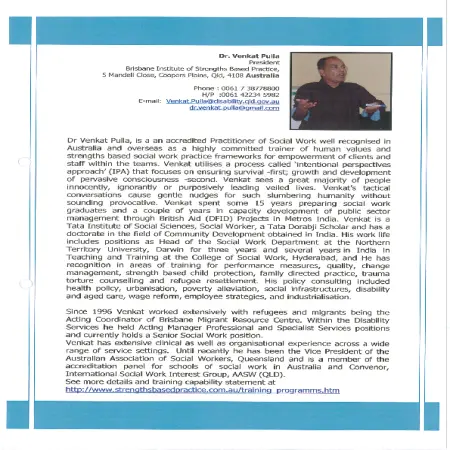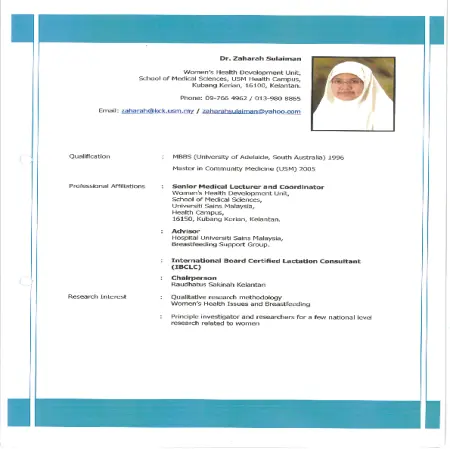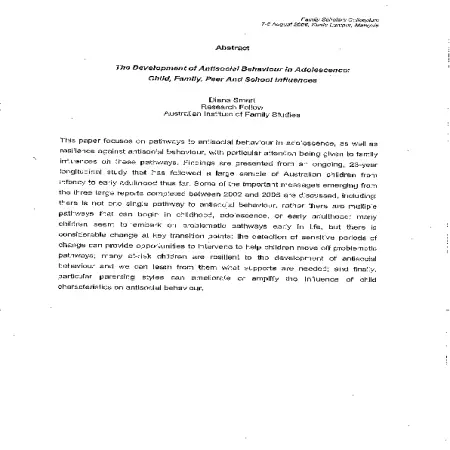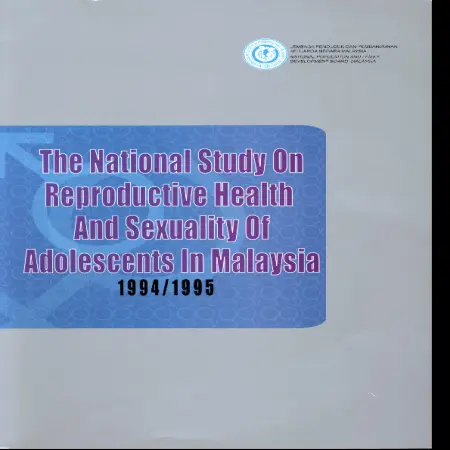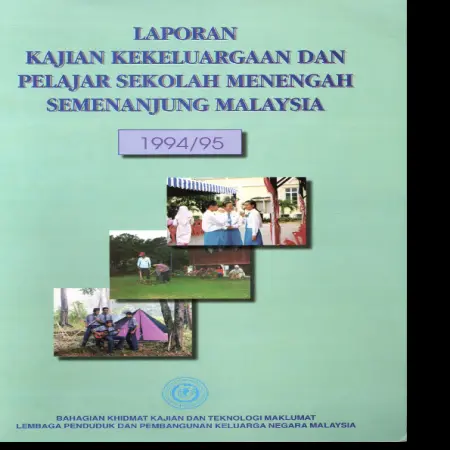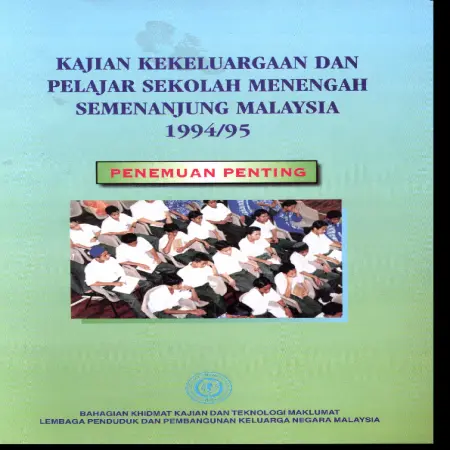TOPICS
Results for Topics : "Adolescent"
|
|
Kajian Pendapat Remaja dan Isu Sosial : mencari penyelesaian
Item Type: Research Report
Editor:
Year: 00/00/2010
Abstract: Introduction of Reproductive and Social Health Education Policy and Action of Plan (PKRS) has been developed which aims to produce individuals who are knowledgeable and have a positive attitude in the field of reproductive and social health. Under the PKRS program, the National Population and Family Development Board (NPFDB) has been given the mandate as the main agency in implementing the program. One of the programs is the Life Skills Program for teenagers which uses two (2) modules, namely the Cakna Diri Module (I’m In Control) and the Kesejahteraan Hidup Module. The purpose of this module developed is to improve adolescents' skills in aspects of reproductive health in order to avoid high-risk behaviors that lead to several problems such as premarital pregnancies, sexually transmitted diseases and HIV. Therefore, an opinion poll was conducted to see the general view on social issues of adolescents, especially from the aspect of reproductive health and the implementation of the Life Skills Program for adolescents.
|
|
|
|
|
|
Understanding coping and resilience of children and adolescents
Item Type: Conference or Workshop Item
Editor:
Year: 00/00/2009
Abstract: The objectives of this paper are to identify and define key concepts and models related to stress, coping, and resilience amongst children and adolescents and also to make us mindful to area wise gaps in our evidence based practice in this context. Amidst the growing evidence that depression and other mental health issues are surfacing amongst children and adolescents in several societies, the author focuses on the transactional nature of coping and resilience and how children and adolescents process a variety of stresses that they see in their day to day lives. Given that children and adolescents attempt to cope well in stressful situations being a fact, the author considers constructing and reviewing this stressful experiences in a person-environment transaction context to be a useful strategy. The paper presents this strategy.
|
|
|
|
|
|
Achievement and challenges in managing female adolescents guidance Centre: experience share from Raudhatus Sakinah Kelantan
Item Type: Conference or Workshop Item
Editor:
Year: 00/00/2009
Abstract: Adolescents today are exposed to various social ills such that they are easily influenced by unhealthy activities, be it directly or indirectly. Many of them have become victims of abuse, maltreatment, neglect, undue psychological stress, rape, incest and others. Raudhatus Sakinah (RS) was thus establish as an institution that provides shelter and guidance to female adolescents who become victims of these social ills. RS strives to offer help to affected adolescents by increasing the level of their confidence and abilities so that they may develop into individuals that contribute positively to society and religion. RS has been in operation since August 1998 under the administration of Wanita Pertubuhan Jamaah Islah Malaysia (WJIM). RS is an established ongoing project to help curb social ills in the society, with special attention to helping adolescents. RS was officially registered under the Care Centre Act 1993 with the Department of Social Welfare. Later in 2004, RS Kelantan was set up in Kota Bharu. RS Kelantan shelters up to a maximum of 25 adolescents girls at any one time. They have to go through a year of rehabilitation program which focuses on spiritual and self development syllabus besides life skills and recreation activities. This paper will focus on the five year experiences, achievement and challenges faced by RS Kelantan in running the centre.
|
|
|
|
|
|
The effect of negative and supportive behaviors of their parents and friends on substance abuse risk among Korean adolescents and implications for family resilience intervention: gender differences
Item Type: Conference or Workshop Item
Editor:
Year: 00/00/2009
Abstract: Substances use among adolescents is particularly because early initiation of substance not only leads to many detrimental impacts on their lives but also is predictive of both increased use and more serious patterns of use in their adulthood. Thus, it is important to identify potential substance users and factors related to substance use because these efforts may provide important information to help adolescents who are at high risk for substance use. Many studies documented that parental alcoholism and peer substance use are the most predictive risk factors for substance use among adolescents. On the other hand, there is ongoing debate among researchers on the influence of social support from family and friends on substance use by adolescents. Also, individual factors such as self-esteem, emotional coping, and academic performance have been shown to be associated with substance use among adolescents. Unlike western society, little is known about gender difference in the prevalence and correlates of substance use among adolescents in South Korea. Accordingly, this study aimed to identify the prevalence of substance abuse risk among South Korean adolescents and to examine the effects of negative and supportive of parents on their substance abuse risk by gender. The participants were 1,981 high school youths between the ages of 16 and 19 years (mean, 17.69) residing in Seoul city. Data collection was conducted conveniently choosing high schools in Seoul. Participants completed a self-report survey which included measures of substances abuse risk of adolescent and his or her best friend (using a POSIT scale), parental alcoholism (using the CAST), supportive behaviors from either parent or friend (using multidimensional scale of Perceived Social Support), Rosenberg's self-esteem scale, COPE scale developed by Carver et al. and gender, age, perceived economic status and academic performance.
|
|
|
|
|
|
The development of antisocial behaviour in adolescence: child,family, peer and school influences
Item Type: Conference or Workshop Item
Editor:
Year: 00/00/2006
Abstract: This paper focuses on pathways to antisocial behaviour in adolescence, as well as resilience against antisocial behaviour, with particular attention being given to family influences on these pathways. Findings are presented from an ongoing, 23-year longitudinal study that has followed a large sample of Australian children from infancy to early adulthood thus far. Some of the important messages emerging from the three large reports completed between 2002 and 2005 are discussed, including: there is not one single pathway to antisocial behaviour, rather there are multiple pathways that can begin in childhood, adolescence, or early adulthood. Many children seem to embark on problematic pathways early in life, but there is considerable change at key transition points; the detection of sensitive periods of change can provide opportunities to intervene to help children move off problematic pathways; many at-risk children are resilient to the development of antisocial behaviour and we can learn from them what supports are needed; and finally, particular parenting styles can ameliorate or amplify the influence of child characteristics on antisocial behaviour.
|
|
|
|
|
|
I'm in Control module (Teenagers)
Item Type: Module
Editor:
Year: 00/00/2000
Abstract: The main objective of the I'm in Control module is to empower teenagers with the appropriate knowledge, attitudes and skills to make informed choices about their sexual and reproductive health. This module is targeted at teenagers aged 13 - 17 years and focuses on building skills to prevent and reduce the risks to pregnancy, sexually transmitted infections and HIV/AIDS. Skills provided include identifying and avoiding high risk situations and using assertive techniques to avoid premarital sex.
|
|
|
|
|
|
The National Study on reproductive health and sexuality of adolescents in Malaysia 1994/1995
Item Type: Research Report
Editor:
Year: 00/00/1996
Abstract: The National Study on Reproductive Health and Sexuality of Adolescents in Malaysia was initiated with the aim of formulating a National Programme on Reproductive Health for Adolescents. The specific objectives of the study are:
i. to establish the status of the knowledge, attitude
and practice of adolescents with regard to sexual
and reproductive health,
ii. to identify the constraints that adolescents face in
seeking information and service relating to sexual
and reproductive health,
iii. to obtain the participation of adolescents in the
design and implementation of programmes and
activities for their own welfare.
The single most expected outcome of the Study on Reproductive Health and Sexuality of Adolescents in Malaysia is a Cabinet memorandum which will propose appropriate policy and programme changes for the promotion and maintenance of optimal reproductive health among Malaysian adolescents geared towards the year 2020. This Memorandum will serve as a vital national reference and benchmark for evaluating future trends and patterns. It will be the basis for the reorientation of values, attitudes and approaches for the management of sexuality and reproductive health of adolescents in the country.
|
|
|
|
|
|
Laporan kajian kekeluargaan dan pelajar sekolah menengah Semenanjung Malaysia 1994/95
Item Type: Research Report
Editor:
Year: 00/00/1996
Abstract: Disciplinary problems among the student are the hot issue that being discuss in our community nowadays. If this problem is not prevented immediately, misbehaviour or disciplinary cases will continue to increase and is about to expose students to more misbehaviour such as theft, blackmail, molesting, involved in triad ,drug addiction and so on. Many discussions about student discipline problems was held, either by the related agencies, associations, schools, parent or communities. According to the report of the Ministry of Education, several key factors are identified as the main cause of disciplinary problems such as school climate less attractive, psychological and familial factors. Detailed and comprehensive study should be conducted to identify family factors that may contribute to or cause students to behave as such. Consequently,a Family Studies and Student Discipline covering high school student and parent / guardian has been carried out in Peninsular Malaysia by the National Population and Family Development Board (NPFDB) in collaboration with the School Division, Ministry of Education and the State Education Departments
|
|
|
|
|
|
Kajian kekeluargaan dan pelajar sekolah menengah Semenanjung Malaysia 1994/95: penemuan penting
Item Type: Research Report
Editor:
Year: 00/00/1994
Abstract: This report summarized the key findings from the report of Family and High School Students Study conducted by the National Population and Family Development Board (NPFDB) in collaboration with the Ministry of Education, Malaysia in 1994. The study covered a total of 1089 students from levels two to five selected from 91 secondary schools in Peninsular Malaysia. Among the 535 students who were selected from those having a record of misconduct while the other 554 did not have a record of misconduct. This study also includes parents of students selected to obtain status information that can be related to the behavior of the students surveyed.
|
|
|
|





